
Jamaican Provisioning Locations Menu: 1 2 3 Next>>
Golden Age of Piracy Provisioning - Jamaica, Page 2
Jamaican Provisioning History
Jamaica's history began with the Taino natives who found the island productive enough to grow sufficient food to trade with the Europeans upon their arrival. When the Spanish occupied the island, they also cultivated some food products. As a result, the island was able to supply "the Spanish homeward-bound merchant ships with fresh provisions, of which the island produced so great an abundance, that it was considered as the granary and victualing place for all these ships."1
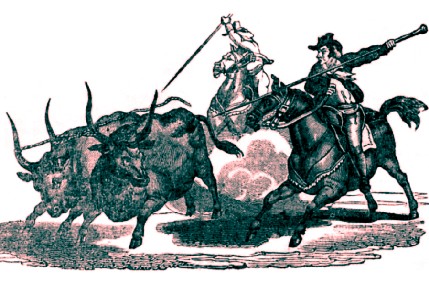
Taking Wild Cattle, From The Penny Magazine (1832)
When the English first arrived, the island was well stocked with meat by the Spanish who had imported cattle and swine.2 Writing about the the Caribbean in the 1630s when the Spanish still controlled Jamaica, navy captain Nathaniel Boteler said "the Dutch as English, which haunt the coasts of Cuba, Hipaniola, and Jamaica, make great use... of the great store of beeves, which run wild upon all these islands, and are easily killed."3 Some of the Spanish hid in the mountains after the English occupied the island, driving many of these animals into the woods so the English could not easily get them. Historian Edward Long notes that because English soldiers used guns to kill the cattle rather than lances like the Spanish, the cattle became frightened by the sound and "became wild, and betook themselves wild to the woods and mountains, so that they were hard to become at"4. As a result, beef became expensive and the soldiers had to find other sources of food.
Eventually the problem with the soldiers was solved by sending away the trouble-makers. Remaining soldiers became farmers along with incoming colonists and they established plantations where
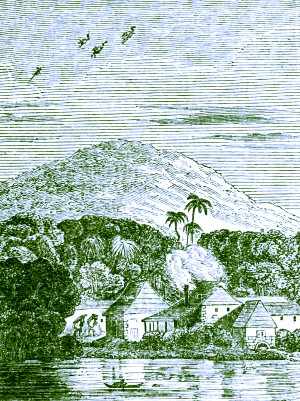
Jamaican Plantation (19th Century)
plants could be grown both for sustenance and export. As Long wrote in 1774:
Jamaica is found to precede all the English plantations in America in the very commodities that are proper to their several colonies; and is also distinguished from them by its producing cacao, hides, tortoise-shell, mahogany, dying- woods, gums, spices, drugs, &c. fruits, fowl, and fish, an infinite store; many of which are unknown to the others; likewise such an abundance of hogs, sheep, horses, and horned cattle, that none other of the English West-India islands can equal it.5
Port Royal rose as the primary English Caribbean trading hub in the Caribbean. Further bolstering trade, raids made by the buccaneers on the Spanish in the 1660s brought large amounts of Spanish wealth into the port and the town flourished. "[T]he great consumption of provisions of all sorts in that town, and for the outfit of so many privateers, created a very large demand for cattle, sheep, hogs, poultry, corn, and every other similar supply furnished by the planters and settlers."6
Turtle was an essential part of the Jamaican market. Naval captain Nathaniel Boteler spends quite a bit of time explaining their importance. He says of the English living in the Caribbean "in lieu of their beloved beef and pork... have found out the salting of tortoises or turtles (as they call them); so that such of them as go abroad for men of war do make it the main of their victualling, when they are homewards bound, and find it very lasting, gustful and wholesome; and so much I can say of it upon my own experience."7
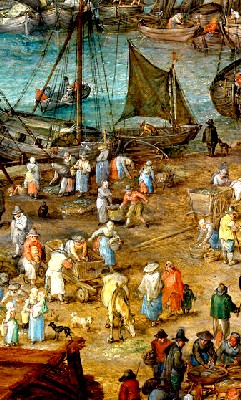
Artist: Jan Brueghel the Elder
The Great Fish Market (1603)
John Taylor described how food was sold in Port Royal when he was there in 1687 and 1688:
Trade was key to Jamaica's role in supplying food to the naval, merchant and privateer vessels which arrived there during this period. An active port meant a lot of traffic and a ready market for food in quantity as Taylor's comment suggests. Two other authors give a view of Jamaican trade around this period, one before and the other after the earthquake and fire razed the town. These provide an interesting view of the city's activity. Map-maker Richard Blome wrote in 1672 around the peak of the Port Royal's trade. Blome said:In this town are three marketts keept every daie, the one an herb and fruitt markett held in the hart of the high street, where stands the stocks and markett bell; to this markett is brought plenty of herbs, fruitts and fowles fresh every morning, unless on the Sabath day. The second market is for fleash and turtle... This market is plentifully stored with beef, mutton, hog, veal, lamb, kid and tortoise, and the cheif times of market is in the cold of ye morning and eavenings. The third market held here is for fish, which is keept on the wharf nigh the Wherry Bridg, where is every morning plenty and variety of excellen fish, verey cheap, soe that for a royall [Spanish real, worth an English sixpence according to Taylor] you may have enough well to satisfie fouer reasonable men's appitites.8
It hath every where good Anchorage, which is so deep, that a Ship of a 1000 Tunn may lay her sides to the shore of the Point, and load, and unload with Planks a Float: which commodiousness, doth make it to be the most frequented by Men of War, and Merchants Ships of any in the Island, and as much Inhabited by the Merchants Storehouse-keepers, Vintners, & Alehouse-keepers, being the only noted place of Trade in the Isle, and doth contain (since the English became Masters of it; about 800 Houses, being about 12 miles and a half in length, and the houses are as dear-rented as if they stood in well-traded Streets in London9
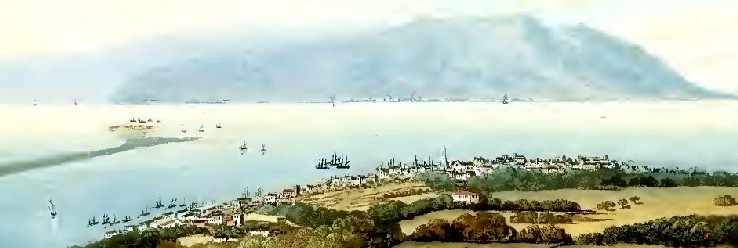 Artist: James Hakewill - Kingston and Port Royal After the Earthquake, From A Picturesque Tour of the Island of Jamaica (1825) |
Author Charles Leslie wrote about the island in a series of letters published in 1741, which he wrote during his stay there around 1720, thirty years after the earthquake and 17 years after the fire.
Here [Port Royal] we cast Anchor, and went ashore. At this Point is Fort-Charles, which guards the Inlet to the Harbour or Bay, and is one of the best Fortifications in America. We got a Boat and made for Kingson, at the Distance of about five Miles; one can’t get at it by Land from Port-Royal, without taking a Compass of upwards of Fifteen Miles, and too is a very dangerous Way.
Kinston is a fine Town, well situated and large; here the most considerable Merchants reside, which makes it a Place of vast Trade; 'tis here likewise the Ships load and unload, and you'll never see less than Two or Three hundred Vessels in the Bay before it.10
The irrelevance of Port Royal and the shift of trade to Kingston by the 1720s is clear from Leslie's letter.
Not all food purchased and consumed on the island was grown there, however. Historian Richard Dunn points out that Jamaica had "plenty of land for provision crops,
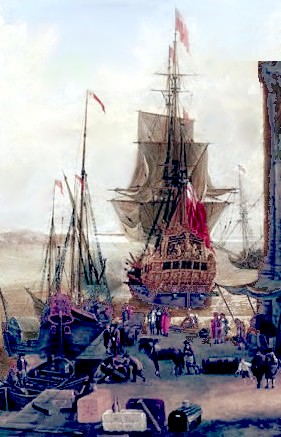
Artist: Jacob Knyff
English and Dutch Ships Taking on Stores (1673)
yet the monied planters in this colony also imported a great deal of their food from abroad, since they would rather eat salted English beef and salted New England mackerel than fresh tropical produce."11 He points out that the typical English plantation owner's diet was focused on "cereals and legumes such as wheat, barley, rye, oats, peas, and beans."12 These same elements are reflected in the sailor's diet which included oatmeal, peas and biscuit (twice-baked bread). Dunn suggests that beef was preferred over pork because most English farms had twice as much cattle as swine. Smoked and salted fish also figured heavily in their diet - all things found in the standard English sailor's diet.
In direct contrast to this, physician Hans Sloane said of his visit from 1687-89, "A great part of the Food of the best inhabitants, for their own Tables, of the produce of the Island, is Swines-flesh, and Poultry of their own raising."13 Being of a scientific and observant turn of mind, mathematician John Taylor commented extensively on the food found and eaten on the island. Among his comments are several that do not seem to agree with the notion that people imported most of their food. He states that "all provitions, and everything which was brought out of England hither, as flower, bred, brandy, win, clouth, etc. was here sold most excessive dear"14. Such steep prices make it unlikely that everyone ate imported provisions. Taylor later lists a variety of local foods and meats, detailing how some of these things were hunted and how well and inexpensively they sold at Port Royal's markets. He also goes into detail about the flavor of the various foods found on the island, indicating that he partook of the local fare.15 Taken with his list of three different markets in Port Royal, it is clear that although the wealthy planters may have preferred the traditional English diet, not everyone had that luxury.
1 Edward Long, The History of Jamaica, Vol 1, 1774, p. 238; 2 Richard Blome, A Description of the Island of Jamaica, 1672, p. 4; 3 Nathaniel Boteler, Boteler's Dialogues, 1929, p. 66; 4 Long, p. 297; 5 Long, p. 294; 6 Long, p. 282; 7 Boteler,p. 66; 8 John Taylor, Jamaica in 1687, David Buisseret, ed., 2010, p. 233; 9 Richard Blome, A Description of the Island of Jamaica, 1672, p. 31; 10 Charles Leslie, A New History of Jamaica in thirteen Letters, 1741, p. 11; 11,12 Richard S. Dunn, Sugar and Slaves, 2000, p. 272; 13 Hans Sloane, A Voyage to the Islands Madera, Barbados, Nieves, St Christophers and Jamaica, Vol. 1, 1707, p. 14 John Taylor, Jamaica in 1687, David Buisseret, ed., 2010, p. 86-7; 15 For more, see Taylor, pp. 133-69
Jamaican Food Descriptions
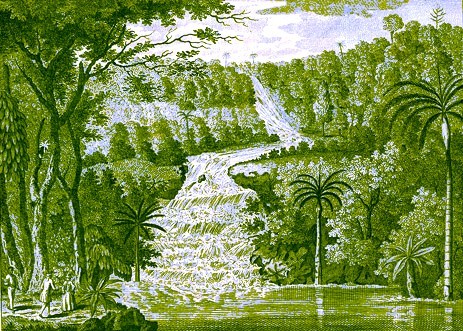
View of the White River Cascade, From The History of Jamaica, By Edward Long (1774)
The variety of foods mentioned by authors discussing Jamaica is even larger than what was found on Barbados, although there is quite a bit of overlap between them. This should not be surprising; many of these foods will appear repeatedly in the islands found in this article because the climates were similar. With so many authors from around the period commenting on Jamaican foods, more information is available to describe them.
It is worth repeating that the presence of these foods in period descriptions do not suggest that they were available to ships as provisions unless this is specifically mentioned. It only indicates that such things were on the island and recognized as food by the person writing. In addition, as the citations in the previous section attest, when sailors were on an island for an extended period (something which frequently happened to merchants and navy sailors in the Caribbean), they would have had more access to the fresh foods offered on an island via the local taverns and inns.
Fruit
Like most Caribbean locations, fruit was produced in abundance and the contemporary authors had much to say about it. Of fruit on Jamaica, Richard Blome says,
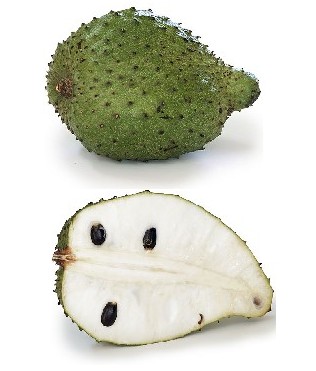
Photo: Muhammad Mahdi Karim - Soursop,, Annona muricata
There are great plenty of choise and excellent Fruits in this Island as Oranges, Pome-granates, Cocoa-Nuts, Limes, Guavars [guavas] , Mammes [Yellow mammee - Mammea Americana], Alumee-Supotas, Suppotillias [sopotas or sapodillas - Manilkara zapota], Avocatas [avocados], Cashues, Prickle-Aples [Harrisia fragrans – a type of cactus fruit], Prickle-Pears [Opuntia – another type of cactus fruit], Grapes, Sower-Sops, Custard-Aples [Annona reticulata fruit], Dildowes [a type of cactus], and many others whose names are not known, or too tedious to name, besides Plantains, Pines [pinapples], &c.1
Charles Leslie lists several fruits in his letters, most of which are included in Blome's list. He adds star apples (Chrysophyllum cainito), pomelos, pinapples, citrons, non-specific berries and Seville and Mandarin (China) oranges.2 Edward Long likewise mentions many of these fruits as well as lemons, bananas, melons (musk-melons) and cucumbers.3 John Taylor covers many of the same fruits, adding muscadine grapes, mulberries, watermelons, coco plums (Chrysobalanus icaco), Jamaican cherries (muntingia), manchineel apples (which are toxic) and figs.4 He also lists several fruits that he says are primarily for medicinal use. However, these will not be discussed here. (For more on medicinal plants and herbs used at sea, see this page.)
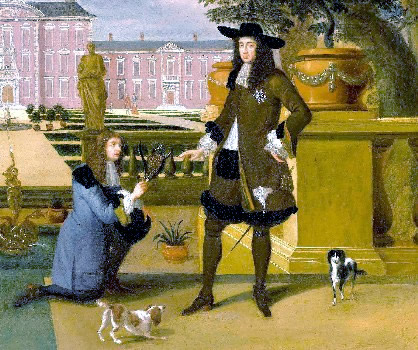
Royal Gardner John Rose Presenting a Pineapple to Charles II (c. 1677)
Taylor marvelled at "the many rare and excelent fruites which this uberous [fruitful] island afordes in great plenty, of their own naturall growth, being such which the lady Europia never enjoyed, neither for the delicacie of Tast or collor."5 Although not quite as extensive as Richard Ligon's comments on the fruit found on Barbados, some of Taylor's comments on the taste and uses of various fruits are interesting and so are included here.
He says the pineapple is "justlie accounted all 'ore the world to be the king of all fruites yet known. ...[It is] a most delicat sweet fruitt filled with meleficious juce, which taste far more dillitious than sweet wine or any other thing which tast is capable to enjoy."6 Historian Edward Long suggests that pineapples were one of the fruits the Spanish settlers enjoyed, which he says sold for sixpence a piece.7
Taylor talks briefly about citrus fruits. He says lemons are "of a verey large size both sweet and sower are found here att all times very plentyfully, and are every way such as are daily sold in England."8 Mandarin and Seville oranges are likewise noted to be very large, although he says they taste pretty much like they do elsewhere. Limes Taylor dismisses as being "only estemed for their juice which serves 'em to help make punch withall."9 Charles Leslie, who lived on the island around 1720, had a more positive opinion of the citrus. "We can likwise boast of the finest Orange and Lemon-trees, in great Plenty."10 He goes on to explain that fruits were so common there "that few mind them", but later adds that with all the tropical fruit, "we were here in a kind of Paradise".11
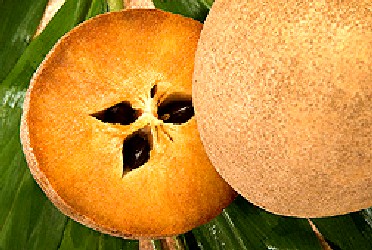
Photo: Peggy Greb, US Dept of Agriculture -
Sapodilla or Naseberry
Taylor comments on the quality of a variety of other fruit found on Jamaica. Like Ligon's comments on the custard apples of Barbados, he praises them as a "verey swett and delirious fruite, composed of a soft substance which eats much like a curious-made custard (from whence it receives its name) and is a fruite much estemed."12 The Jamaican cultivated figs "which grow here are a verey larg, choice, and delicious fruite, fare larger and better than any which grow either in Spain, France or England. They have all ye vertues of the Europian figg."13 Taylor calls naseberries (sapodillas) "rare and excellent fruite and are of the choicest found in the West Indies. This fruit is ...verey full of a meleficious [melifluous - pleasant] juice, and a most rare flavoured fruit of good esteme."14 He explains that bananas are "full of juce, soft and of a most plesant tast. Of this fruit is made a better marmalad or concerve than of quinces. Also of the juce of this fruit is made an excellent wine, very plesant and good for presant drinckeing"15.
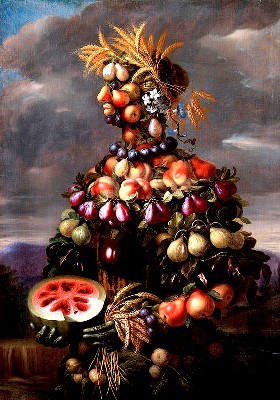
Artist: Giovanni Stanchi -
Summer Fruit Allegory (c. 1645-72)
Taylor also admired the melons found on the island. He calls watermelons 'royall' fruit, explaining that they are "redd and white, fare better than those found either in Spain or Italy... the inside is compos'd of a white melleficious juice substance, and the juce of ye whit wattermellon is cleare like watter and sweet like wine, and the red watermellon is fill'd with melleficious redish juce like clarret wine."16 He notes that they are "sold at Port Royall for a royall apeice, and are a fruite generally served up at dinner"17. Jamaican-grown muskmelons "are much better and sweeter and quadruple as large [as those in England], being as bigg as our English pompions [pumpkins]."18
Avocados, which he calls alligator pears, are "a jucie fruice, firme and solid, about the bigness of a penny loaf, and is counted an excellent frute, a great restorative in consumptions, and increaser of seed and lust, soe that the Spaniards will not suffer their wives to eat thereof, least it should propigat their lust beyound their satisfaction. 'Tis ...eaten by the English with salt, peper and ye juice of a lemmon."19 They are another of the fruits that historian Long says the Spanish preferred, selling "at threepence: these probably had not long been introduced here; and, being more scarce, were thought more estimable than the rest."20
According to Taylor, the papaya ('paupa') is "a large fruit, about the size of a large English cowcumber, not round but on squares, covered with a smoth green chinn skinn, and in the inside cavious and full of seeds. This fruite is seldom eaten raw, but is commonly boyled with salt beef or porke and eates excellent sweet and good, being of holsome nutriment"21. Of the 'cowcumber', he later says that it inn "every way such as is found in England, but larger and better"22. However, he also warns that there are wild cucumbers (actually Echinocystis lobata) growning on the island which are of a poisonous nature. In fact, the fruit is inedible causing burning reactions when eaten by some people.23
1 Richard Blome, A Description of the Island of Jamaica, 1672, p. 25; 2 Charles Leslie, A New History of Jamaica in thirteen Letters, 1741, p. 14 & 37; 3 Edward Long, The History of Jamaica, Vol 1, 1774, p. 239; 4 John Taylor, Jamaica in 1687, David Buisseret ed, 2010, p. 188, 192-3 & 206; 5 Taylor, p. 206-7; 6 Taylor, p. 207; 7 Long, p. 239; 8,9 Taylor, p. 208; 10,11 Leslie, p. 14; 12 Taylor, p. 208; 13,14 Taylor, p. 209; 15,16,17,18 Taylor, p. 210; 19 Taylor, p. 211; 20 Long, p. 239; 21,22 Taylor, p. 213; 23 Susan Mahr, "Wild Cucumber, Echinocystis lobata". University of Wisconsin website, gathered 3/20/20
Vegetables
Quite a wide variety of vegetables were grown and eaten on Jamaica according to contemporary authors. Physician Hans Sloane talked in some depth about the flora and fauna he observed on Jamaica when he lived there.
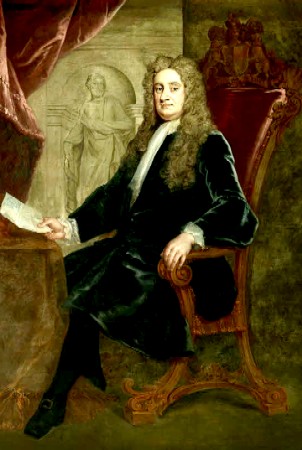
Artist: John Vanderbank (att.) - Hans Sloane (early 18th c.)
He lists the widest variety vegetables of all the authors, first focusing on roots and then moving on to the parts which grew above ground. He makes an interesting observation regarding the latter category: "Though Stalks and Leaves afford no great Nourishment, yet they have sometimes kept many from starving, they are either such as are tender or succulent of themselves, or made so by earthing [covering them with dirt]."1 From this, it appears that the medical community had low regard for non-root vegetables as a food (at least according to Sloane).
Sloane's list of root vegetables "affording Sustenance, are Carrots, Parsneps, Parsly, Navews [brassica rapa], Skirrets [Sium sisarum], Radishes, Onions, Turneps, Scorzonera [black salsify], Sassasie or Tragopogon [another type of salsify], Peony, Gladiolus, Papyrus, Fennel, Daucus [Queen Anne's Lace]"2. He separately lists the non-root vegetables, including several things we would today regard as herbs:
Cichory, Selery, Endive, Sorrel, Coleworts [cabbages], Mallows [the malvaceae family plants which includes okra], of much use in the Kitchin of old, Bugloss, Lettuce, Blite [Amaranthus blitum], Cumfry, Spinage, Leaves of Apples, Pears, Beech, Artichokes common and prickly, Mushrooms, Purslain, on which some people have lived in desert Places, Sium [water parsnips], Primrose, Cefaglione or the head of the Dwarf Palm, the Head of the Palm called Cabbage-tree [referring to hearts of palm which can be harvested from several palm trees], Asparagus-like, young Shoots of Briony, black and white, Hops, Ruscus, Equisetum [horsetail], which is reckon'd unwholesome, and Ferula, Sea weeds, tender Leaves and Sarments [branches] of Vines, White thorn, and Tamarind tree-leaves. …Many feed on Pulse [edible seeds found in pods], as Pease of the Garden, and wild Beans, Vetches [vicas - a plant, one of the varieties of which produces a type of bean], Orobi [probably Vicia orobus, a type of vetch], Lupins, Kidney-beans, Lentils, Lotus Ægyptiaca [Nymphaea nouchali - a type of water lily].3
Although he was likely referring to specific plants found on
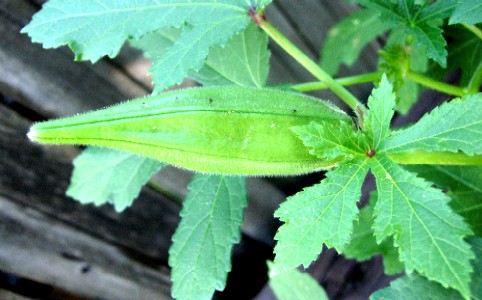
Photo: Joe Sala - Okra Growing
Jamaica, some of the plants Sloane mentioned in the above entry are today known to be families of plants making them difficult to identify as a particular plant. These include mallows, bugloss, ruscus, ferula and vetches. Richard Blome's list includes eight vegetable plants. Most of them are the same as those listed by Sloane, although he adds parsley and cauliflower.4 John Taylor talks about a variety of 'European vegetables' grown on the island including garlic, shallots, leeks and horse-radish. When discussing carrots and turnips, Taylor explains that they "grow here very small and are sold verey dare [dear] at Port Royall market, soe that you shall have but one small bunch of' em for a royall or an English sixpence."5 He also says that okra "in my opinion is the king of hearbs which I ever saw. 'Tis a most excellent sallad, and boyled"6.
Taylor makes some interesting comments about a few of the vegetables mentioned. He says the heart of palm (which he calls cabbages, probably because the tree
Photo: Ricardo Eliezer de Souza - Harvested Hearts of Palm
they come from a tree colloquially called the cabbage palm) on Jamaica comes from
the upper part of the tree, which yett is fill'd with sapp, soft and tendor, being not as yett wood, for you must understand that about a yard of the very top part of the tree you must cutt off with a knife, for 'tis verey soft, and after you have taken off the bark, and another filmn, the remain part is the cabadge, very white, sweet, and tendor. …The cabadge raw eats as sweet as almonds and makes a good sallad, which must be eaten carefully for 'twill occation a lask [diarrhea], but when the cabadge is boyled it eats every way like our Europian cabadge, butt sweeter.7
Sloane cites a number of other authors who note that the tops of these trees are used in place of bread, are as sweet as a nut and can be boiled or eaten raw like Artichokes.8
Taylor talks about a plant he calls collaloa, by which he means amaranth.
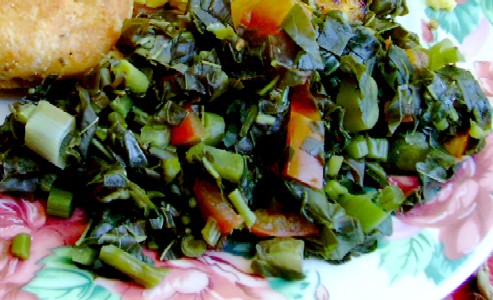
Photo: Wiki User Karolyn - Jamaican Callaloo, Usually Served With Breakfast
He says "This hearb boyled by itself, or with potatoa leaves with salt beef or pork, eateth much better than colworts [cabbage]."9 This dish is today called callaloo and is still made in Jamaica, being made with sauteed onions, salt and pepper, among other ingredients.10
Several authors also discuss the value of sweet potatoes. Sloane says they are "for the most part oblong, as big as a Hen-Egg, from a swell'd middle tapering to both extremes, yellow, and sweet within when roasted, tasting like a boil'd Chesnut, and having many fibrils, by which it draws its Nourishment."11 John Taylor has much to say about these root vegetables. He notes that they are found on every plantation being 'most delicate'
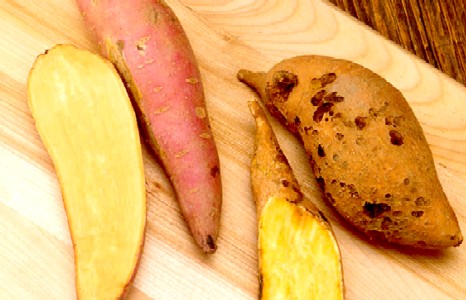
Photo: Library of Congress - Red and White Sweet Potatoes (But Not Yams)
such which the lady Europa never enjoyed in hir garden, and they are of two sorts, a red and a white. These ro[o]tts grow in sundry shapes; some are long, otheres ovillar, but the major part of 'em irregular and knobbly. This roots are verey drie and sweet, of most excellent nutriment, and of great profitt to the painfull [diligent] planter, for with them he feedeth his servants in his famally, and his Negroas slaves, but allso with this root they make an excellent sort of cold drinck, called rapp and mobby, which is a plesant cold liquor. Both these sorts of potatos are both of one nature and tast, and are here commonly roasted and eaten insteed of bread. They eat drie and as sweet as honny, and are sold at Port Royall market some ten or twelve pouinds for a royall or an English sixpence.12
Taylor's description suggests that they were not generally eaten by the English, rather being fed to the slaves and servants (referring to indentured servants brought from Europe.) Taylor talks on the same page about yams, which he notes is used in the same way as potatos and particularly to make bread. (There is actually a difference between sweet potatoes and yams having to do with the number of embryonic seed leaves on the two different plants.13)
1 Hans Sloane, A Voyage to the Islands Madera, Barbados, Nieves, St Christophers and Jamaica, Vol. 1, 1707, p. xxii; 2 Sloane, vol. 1, p. xxi; 3 Sloane, vol. 1, p. xxii; 4 Richard Blome, A Description of the Island of Jamaica, 1672, p. 25-6; 5 John Taylor, Jamaica in 1687, David Buisseret ed, 2010, p. 217; 6 Taylor, p. 203; 7 Taylor, p. 193-4; 8 Sloane, vol. 2, p. 116-7; 9 Taylor, p. 205; 10 For a simple vegetarian version of this recipe, see "Steamed Callaloo" on jamaicans.com; 11 Sloane, vol. 1, p. 150; 12 Taylor, p. 217; 13 "Everyday Mysteries: What is the difference between sweet potatoes and yams?", Library of Congress Website, gathered 3/21/20

